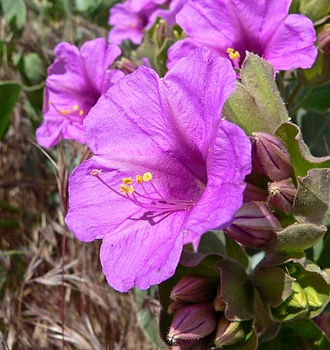I won't forget the first time I saw Mirabilis multiflora, commonly known as Colorado Four-O'clock, while hiking on the East side of the Owens Valley. I stood there staring at this bush full of bright pink flowers, thinking it looked like a tropical plant plopped down among our stoic sage. Later I read that bougainvillea is in the same family, the Nyctaginaceae family, with many tropical plants.
These bright flowers are tubular shaped, with five lobes. They are about one inch across and 1.5 inches long. The leaves are arrow head shaped, the bush growing in a domed mass. The flowers had just started opening that day in the late afternoon, and it's this feature that gives the four-o'clocks their common name. Opening in the late afternoon or evenings, the flowers wither during the next day, with more flowers blooming again in the afternoon. Insects that forage late in the day are particularly attracted to the blooms. The large pink and brown Sphinx moths, that are often mistaken for hummingbirds, are frequent visitors. Hummingbirds also visit the flowers as do native bees and butterflies.
This first Colorado Four-O'clock I saw was blooming out in the open in full sun, growing on a gravelly slope. However, the USDA notes list the light requirements of this plant as partial shade to sun. The notes also state that all native Four-O'clocks in the Western US prefer dry sandy or gravelly soils.
Mirabilis multiflora is an herbaceous perennial, growing a large taproot and dying back to the root each winter. In your garden, it can be cut back in the late fall. A mature plant can get to three feet across and about eighteen inches high. Plant it where it will have room to spread. It is suggested as a good plant for erosion control, and that it looks well spilling over the edge of rock walls, or retaining walls. It should also be a good addition to hot and dry areas of the garden that are a challenge for many plants. When first planted water regularly, but once established the plant will need little supplemental water.
Our local chapter of the California Native Plant Society, the Bristlecone Chapter has listed Mirabilis multiflora on their website as a plant that has sometimes been offered at their annual plant sales. Four-O'clocks more commonly found at nurseries are Mirabilis jalapa, a non-native plant. This plant is also called “Marvel of Peru,” it is a perennial from South America, noted for the flowers' pleasant scent. In colder climates, Marvel of Peru is not reliably hardy. The tap root can be overwintered by digging up and storing in a dark frost free spot and planted up again in the spring. It can also be treated as an annual and let reseed in the garden. Be cautious where you plant either of these Mirabilis species as the seeds have a minor toxicity if eaten, and the roots may cause dermatitis when handled. Consider planting in spots away from play areas.
Other common names for Mirabilis multiflora are Desert, Wild, Large or Showy Four-O'clock. It is a very showy and wild looking Four-O'clock. The blooms provide nectar and pollen from dusk to dawn, possibly into the next day, and are a vibrant pink color. This could be a wonderful addition to an area of the garden especially enjoyed in the evenings.
Mirabilis multiflora
- Rounded bushy form
- Perennial
- Herbaceous
- Low water use
- Part shade / sun
- Dry, well-drained soil
- Showy flowers, pink-magenta
- Many flowers open at once
Resources:
University of California: Safe & Poisonous Garden Plants: ucanr.edu/sites/poisonous_safe_plants/
California Native Plant Society, Bristlecone chapter: bristleconecnps.org
USDA Forest Service: www.fs.fed.us/wildflowers
